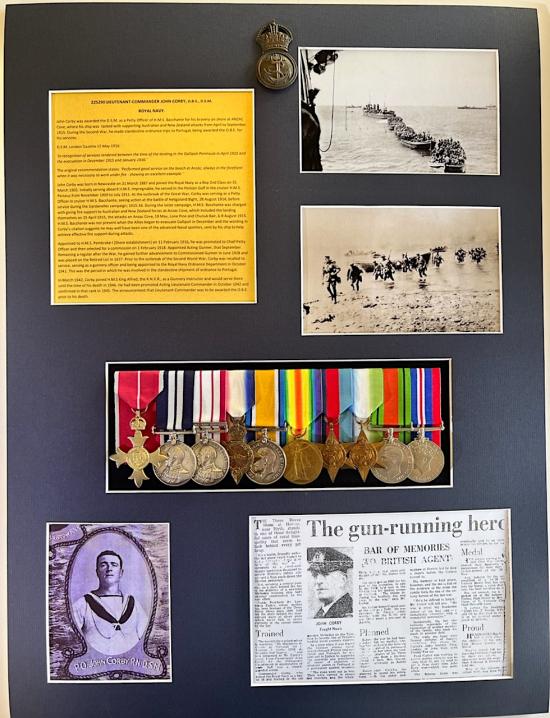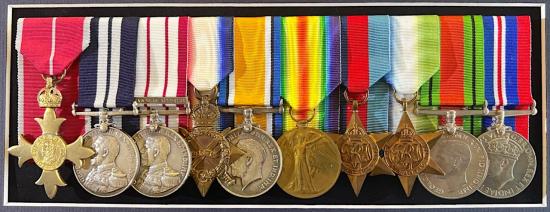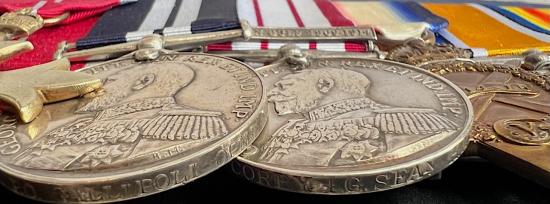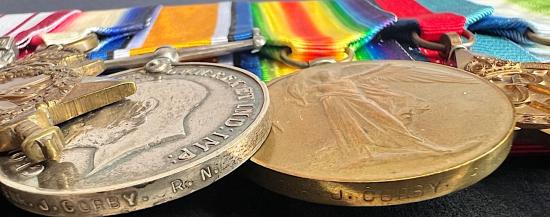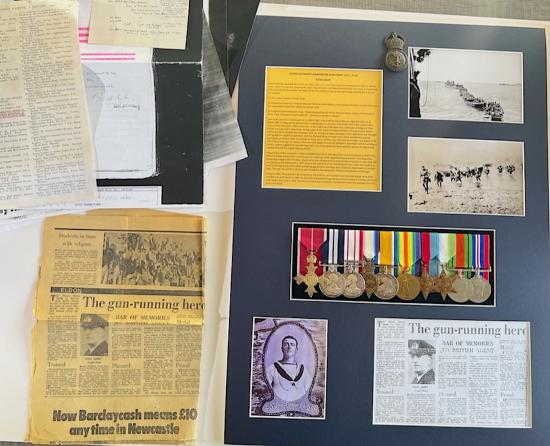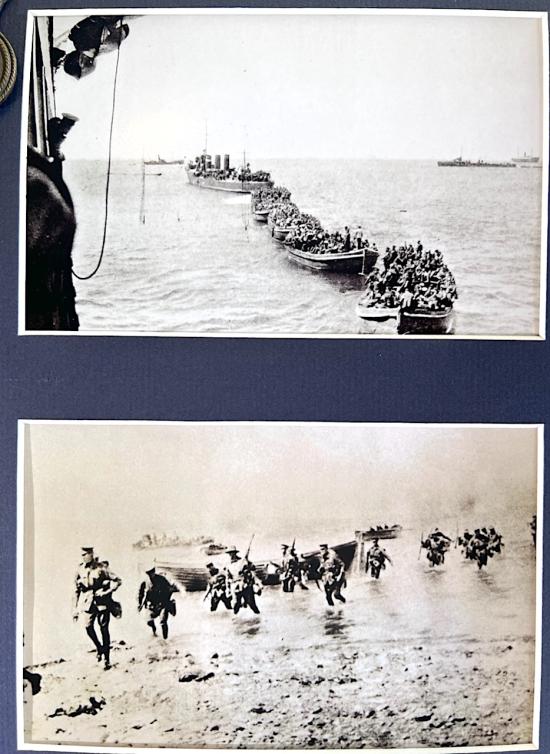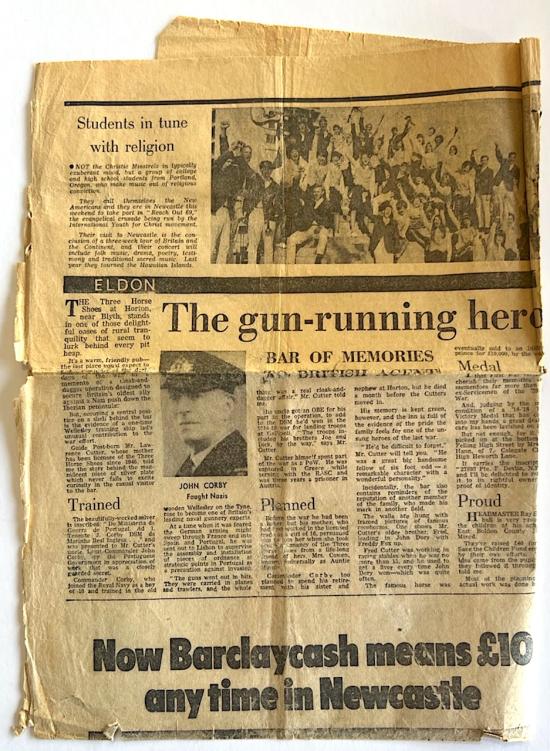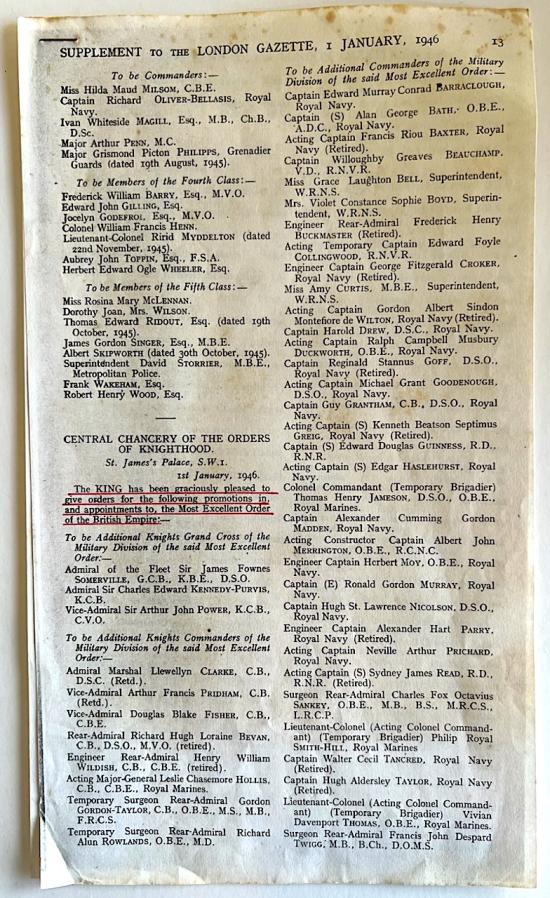WW1 ANZAC COVE BEACH LANDING DSM GROUP LT. CDR. JOHN CORBY
ANZAC Beach First Day Lander Distinguished Service Medal and WW2 Military O.B.E. to Lieutenant Commander John Corby.
A Second War O.B.E., Great War D.S.M. Group of ten awarded to Lieutenant-Commander J. Corby, Royal Navy, who as a Petty Officer of H.M.S. Bacchante was decorated for bravery on shore at Anzac Cove, where his ship was tasked with supporting New Zealand and Australian attacks from April to September 1915. During the Second War, he made clandestine ordnance trips to Portugal, being awarded the O.B.E. for his services.
The Most Excellent Order of the British Empire, O.B.E. (Military) Officer’s 2nd type breast badge, silver-gilt; Distinguished Service Medal, G.V.R. (225290 J. Corby, P.O., Gallipoli Opns. 1915-16); Naval General Service 1915-62, 1 clasp, Persian Gulf 1909-1914 (225290 J. Corby, Lg. Sean., H.M.S. Perseus); 1914-15 Star (225290 J. Corby, P.O., R.N.); British War and Victory Medals (Gnr. J. Corby, R.N.); 1939-45 Star; Atlantic Star; Defence and War Medals 1939-45. Good very fine.
O.B.E. London Gazette 1 January 1946.
D.S.M. London Gazette 15 May 1916: ‘In recognition of services rendered between the time of the landing in the Gallipoli Peninsula in April 1915 and the evacuation in December 1915 and January 1916.’ The original recommendation states: ‘Performed good service on the beach at Anzac, always in the forefront when it was necessary to work under fire - showing an excellent example.’ John Corby was born in Newcastle on 31 March 1887 and joined the Royal Navy as a Boy 2nd Class on 31 March 1905. Initially serving aboard H.M.S. Impregnable, he served in the Persian Gulf in the cruiser H.M.S. Perseus from November 1909 to July 1911. At the outbreak of the Great War, Corby was serving as a Petty Officer in cruiser H.M.S. Bacchante, seeing action at the battle of Heligoland Bight, 28 August 1914, before service during the Dardanelles campaign; 1915-16. During the latter campaign, H.M.S. Bacchante was charged with giving fire support to Australian and New Zealand forces at Anzac Cove, which included the landing themselves on 25 April 1915, the attacks on Anzac Cove, 19 May, Lone Pine and Chunuk Bair, 6-9 August 1915. H.M.S. Bacchante was not present when the Allies began to evacuate Gallipoli in December and the wording in Corby’s citation suggests he may well have been one of the advanced Naval spotters, sent by his ship to help achieve effective fire support during attacks.
Appointed to H.M.S. Pembroke I (Shore establishment) on 11 February 1916, he was promoted to Chief Petty Officer and then selected for a commission on 1 February 1918. Appointed Acting Gunner, that September. Remaining a regular after the War, he gained further advancement to Commissioned Gunner in June 1928 and was placed on the Retired List in 1937.
Prior to the outbreak of the Second World War, Corby was recalled to service, serving as a gunnery officer and being appointed to the Royal Navy Ordnance Department in October 1941. This, then, the period in which he is believed to have been involved in the clandestine shipment of ordnance to Portugal, an aspect of his career discussed in the Evening Chronicle of 24 July 1969: ‘Behind the bar of the Three Horseshoes public house in Horton, near Blyth, is a magnificent piece of silver plate which never fails to excite curiosity in the casual visitor. The beautifully worked salver is inscribed “Do Ministeria da Guerra de Portugal. Ad 1. Tenete J. Corby D.S.M. da Marinha Real Inglesa” and was presented to Mr. Cutter's uncle, Lieutenant-Commander John Corby, by the Portuguese Government in appreciation of work that was a closely guarded secret ... Commander Corby, who joined the Royal Navy as a boy of 16 and trained in the old wooden Training Ship Wellesley on the Tyne, rose to become one of Britain’s leading naval gunnery experts. At a time when it was feared that the German armies might sweep through France and into Spain and Portugal, he was sent to Lisbon to supervise the assembly and installation of pieces of ordnance at strategic points in Portugal as a precaution against invasion. “The guns went out in bits. They were carried in planes and trawlers, and the whole thing was a real cloak and dagger affair. My uncle got an O.B.E. for his part in the operation to add to the D.S.M. he had won in the 1914-18 War for landing troops at Gallipoli,” said Mr Cutter.’
In March 1942, Corby joined H.M.S King Alfred, the R.N.V.R., as a Gunnery Instructor and would serve there until the time of his death in 1946. He had been promoted Acting Lieutenant-Commander in October 1942 and confirmed in that rank in 1945. The announcement that Lieutenant-Commander was to be awarded the O.B.E. prior to his death.
Comes with an original copy of a Christmas booklet published by the Cadet Training Ship Wellesley, in which appears a photograph of the recipient. as a young rating, shortly after he had been cited for gallant deeds in the Gallipoli operations; together with the newspaper cutting quoted above.
Code: 50865
7800.00 NZD

